This chapter is designed to help you understand what SharePoint Team Sites (Sites) are and what content and information a Site can provide for your own specific purposes. This will ultimately allow you to architect an entire portal.
This chapter will cover:
- Site overview
- Libraries and lists
- Creating sites
- Site security for your team
- Managing users and groups
- Creating and managing navigation
- Changing the UI-themes
Understanding the site overview can be confusing because there are many terms that people often misuse. The word Site can refer to the entire portal when in fact a portal can be a collection of Sites, referred to by Microsoft as a Team Site. Another term you should also be aware of is Site Collection.
A site usually represents a functional department or activity in an organization, such as sales or marketing in a project. Because there may be multiple collaboration activities, a site would normally be created to accommodate these activities.
Sometimes functionality activity needs to be split into separate sites within a site, perhaps because there is so much content, different branding, or because security is required. When this is a requirement, a sub site is created, which is a site within a site.
A site collection normally has a top-level site with multiple sites below it. Each site in the collection can have a unique template, settings, and content. These features can also be shared among sites to provide a consistent authoring environment with shared site columns, content types, web parts, and workflows.
By deploying sites within a site collection, the benefit to the user experience is unified navigation, branding, and search.
In fact, a SharePoint installation within a company can have multiple Site Collections that can contain multiple Sites. The Site Collections will normally have different business purposes such as an extranet, company intranet, and marketing business-to-business (B2B) portal; these are defined by a SharePoint Administrator.
The SharePoint components mentioned are illustrated in the following figure:
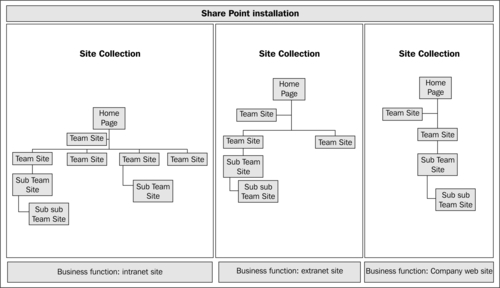
The Sites within the different Site Collections, as illustrated in the preceding figure, store information in libraries or lists.
Libraries have very similar functionality to lists, with the main difference being that they contain documents, not list items. The documents are not limited to MS Office; any document, including PDFs, CAD, and MP4 files (among others) can be found in libraries.
Note
MS Office 2010 files have greater integration with the SharePoint technology with the ability to apply metadata to a file (discussed later in the chapter), start a workflow, and experience shortcuts to SharePoint libraries through the Office Ribbon interface. Other Office integration features include SharePoint WorkSpace, which allows SharePoint content to be taken offline, and PowerPoint broadcasts, which allows PowerPoint presentations to be broadcast to the Internet.
Links to libraries are listed on the side navigation or Quick Launch of a Site, and are categorized. In the following screenshot, the categories are Libraries, Lists, and Discussions.
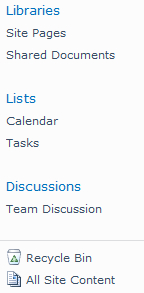
Tip
The Quick Launch side navigation can be manually changed so it is not always the case that a list or library will be displayed on the side navigation. Links on the Quick Launch could link to forums, dashboards, web pages, SharePoint pages, or a non-SharePoint site(s).
To view the Shared Documents library, the user can click on the Shared Documents link.

The preceding screenshot shows a typical document library with documents stored in it and document associated data: Name (which is the name of the file), last Modified, and Modified By. These are field information (or metadata) that are associated with the document or information. SharePoint terminology refers to this information as Columns. Additional columns can also be added to a document library to provide greater metadata options to the content. Metadata is data on the data.
By clicking on the top of a column header, the document library is sorted similarly to a column in Excel. Obviously, the more columns that are displayed, the greater the ability to sort and filter displayed information.
Note
There can only be so many columns on the page until horizontal browser scroll bars are displayed at the foot of the browser, which presents a cluttered user experience. If it is really necessary to have large amounts of field information displayed, create different views in the library. This will keep the user more focused on relevant information.
Information in a Document Library can be viewed in different ways. Select the downward arrow next to the view name on the ribbon as shown in the following screenshot:
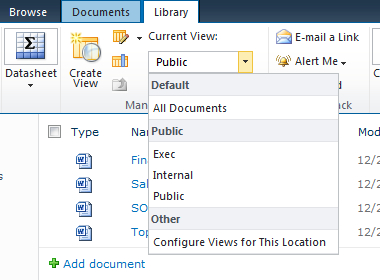
In the preceding screenshot, there is a single view of All Documents, and by clicking on it this view will be displayed.
When users first start working with SharePoint's document library, they tend to copy the existing folder structure network drive, with files stored in the same folder location. This is a good practice as it gains user buy-in because they are familiar with the content structure.
Over time, when users become more familiar with their requirements and SharePoint's functionality, they begin to create views within libraries to filter content.
Views are discussed in detail in the following chapter.
When a document is selected, the Ribbon dynamically changes to show additional user actions for the selected item, hence the interface is more intuitive and therefore similar to Office 2010.
Before selecting the document, you would see something like this:
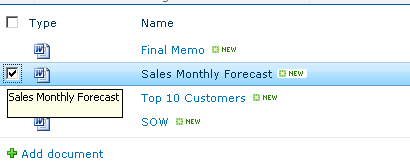
Afterwards, the ribbon dynamically changes to this:

SharePoint has several Ribbons (the preceding screenshot is for libraries). There are two tabs on the Ribbon that are important: Documents and Library.
- Documents: This represents all actions related to the document, such as Check Out, Edit the document, and so on.
- Library: This represents all actions related to a library, such as create versioning, set up an alert notification, or create a view on the library. Some of these actions will require appropriate permissions.
A SharePoint list is a collection of similar items that contain columns or fields that define the item data or metadata schema. Each item stored in a list shares the same schema.
The built-in lists on a Site are announcements, contacts, events, tasks, discussion and issues lists. When you create your own lists, you can either base them on the designs used for the built-in lists, or you can create a Custom List.
A list will contain items such as a Calendar entry. The following screenshot illustrates a calendar list in a calendar view, with each calendar entry representing an item.
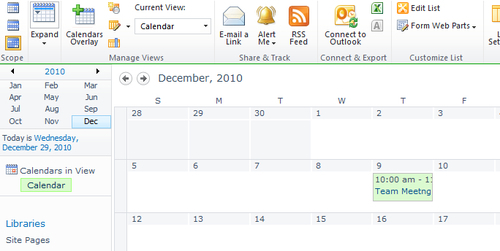
By clicking on the item, the whole entry can be seen.
When an item is in a list, the Ribbon dynamically changes to show additional user actions to the selected item. The following screenshot shows the Ribbon for the Calendar list. Note that there are some subtle differences to the Library Ribbon, including syncing up the calendar on SharePoint with the user's Outlook calendar, exporting the items into Excel, or querying the items in MS Access.

Generally, information that would normally reside in a row on a spreadsheet can be an entry in a list. The advantage of having this information now stored in a list is that it is accessible to members of your team and actions can then be associated with it, such as workflow, alerts, and version control, all of which is discussed in the next chapter.
Workflows, alerts, and control functionality are available in document libraries.
